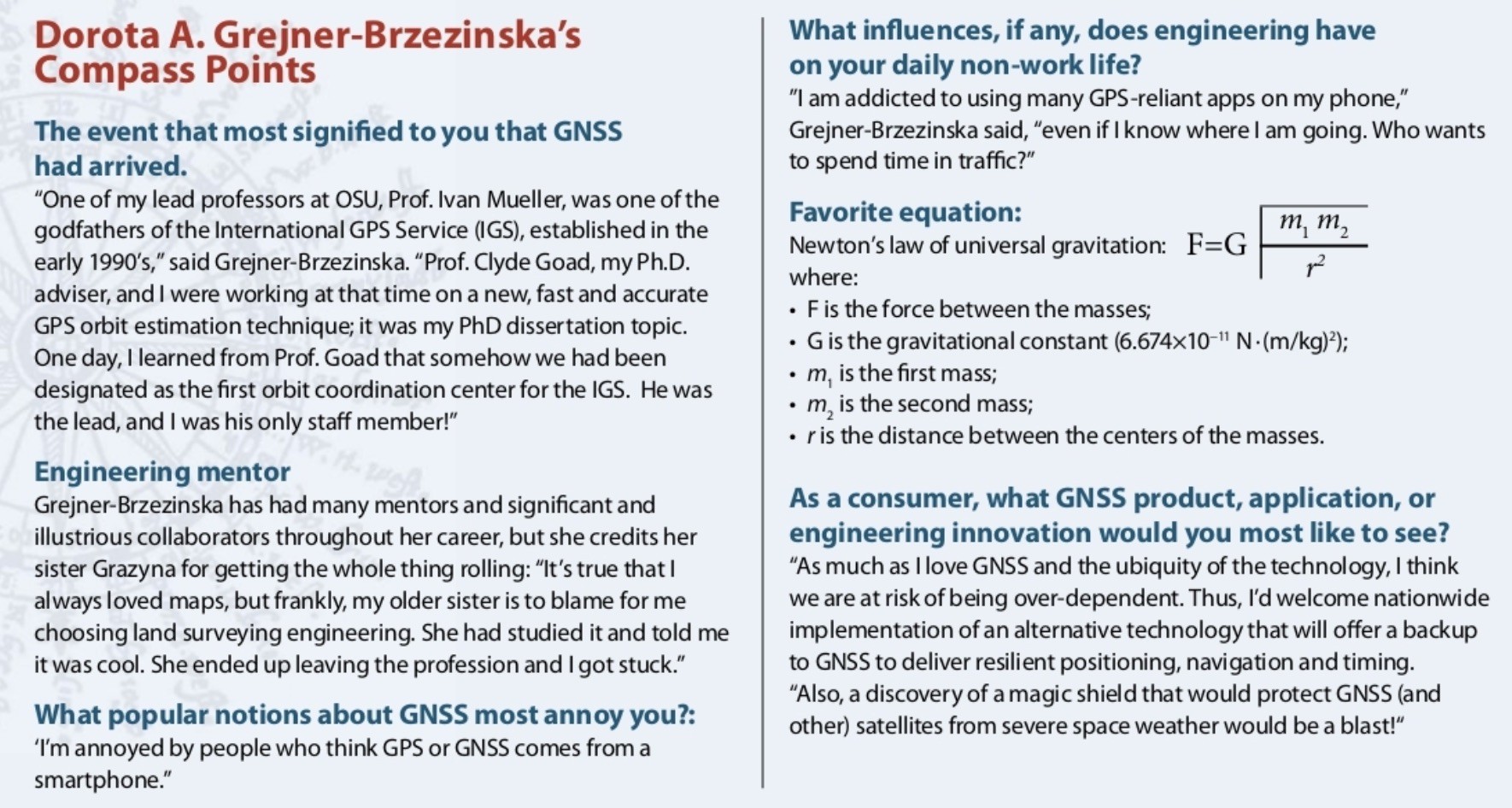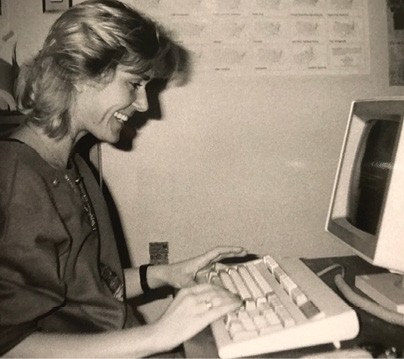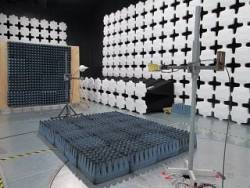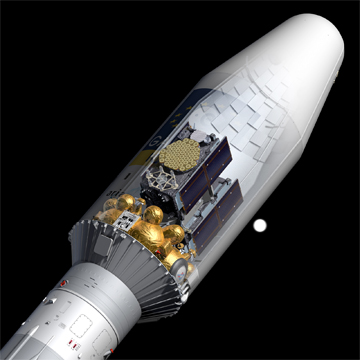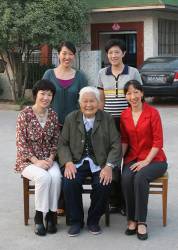When Dorota A. Grejner-Brzezinska left her native Poland to study GPS in the United States, little did she know her work there would go on for three decades and take her to the world’s farthest reaches. Today, as University Distinguished Professor, Lowber B. Strange Endowed Chair, Associate Dean for Research, College of Engineering and director of the Satellite Positioning and Inertial Navigation (SPIN) Lab at The Ohio State University, she leads a team of front-line GNSS researchers that is revolutionizing how we map and navigate.
Dorota A. Grejner-Brzezinska was born and raised in Olsztyn in Warmia, northeastern Poland, known as the region of a thousand lakes. “My family lived in a suburb, in a home with a giant garden,” she said. “It was the same house where my father had lived with his parents and siblings.” Flowers and a tall pear tree grew in the front yard, and apple and cherry trees in back.
“Ever since I can remember, I was always busy exploring the garden and the neighborhood, “said Dorota, “inventing games with my friends, building a tepee or an igloo, depending on the season, riding a bike, making sand castles and climbing trees – the first and the sweetest apples and pears were always mine!”
The Heroes Were Real
Dorota grew up listening to stories of heroes and villains, of daring escapes in the night and tearful reunions. But these were not make-believe, romantic tales. They were the living memories of her own family.
Dorota’s mother, Irena Grejner (née Narkun), was born in 1940, during WWII, on a farm in a village called Obaliszki, in Belarus, then a part of Poland. During the war, Dorota’s grandfather, Jozef Narkun, supported underground forces loyal to the Polish government in exile, often harboring wounded fighters and providing food and supplies. At the end of the war, he and his brothers were condemned for their actions and sent to Siberia by the Soviet authority. He was eventually freed, but was transported directly to Poland without a chance to retrieve his family in Belarus.
“It was nearly four years before my grandfather was allowed to bring his children to Olsztyn,” Dorota said. “My mom still tells the story of the long train trip with her sister and brothers to finally be reunited with my grandfather.”

Dorota’s father, Boleslaw Grejner, was born in 1935 and grew up in the small town not far from Lvov, Ukraine, also part of Poland at that time. During WWII, guerilla groups carried out murderous attacks on ethnic Polish families in that area. One night, to save their lives, the family packed their bare necessities, including grandparents (Dorota’s great-grandparents), and escaped into the woods. Dorota’s grandfather fought with the Polish underground and eventually joined the 2nd Polish Army that marched alongside Soviet troops all the way to Berlin, where he witnessed the victory over Nazi Germany.
“During the years when my grandpa served in the underground, his family lived in a hideout deep in the woods. My dad and his sisters would go to the nearby village, where German units were stationed, to count the soldiers, tanks and armored vehicles, to provide ‘intel’ to their side. After the war, my grandfather remained an officer in the Polish army, stationed in Olsztyn.”
After finishing high school in their new hometown, Dorota’s parents both worked at the same newspaper office. Their two families, which had supported opposing factions during the war, were about to be united. The fateful moment came one evening at a local party, when her father couldn’t take his eyes off her mother, and the couple danced.
“It seems she was a very attractive young woman,” said Dorota. “Soon after, my father asked my mom’s father if he could ask her out on a date, and she made sure that her father said yes.” The couple were married in 1959. Poland was one again. Two daughters arrived, Grazyna in 1961, and Dorota in 1963.
Childhood Memories
“Some of my earliest memories are of my sister trying to teach me to read,” Dorota said. “ I tried to be nice and cooperate, but most of the time I was too busy running around, playing with my toy soldiers and Indians and box cars and building crazy contraptions with building blocks; I was a classic tomboy. When I got older I was on the school swim team and later I was recruited by the track and field, basketball and volleyball teams.” Dorota was an excellent student and participated in many student clubs. “I would always be the one to stand up to a bully and make friends with the less popular kids, the ones who did not fit in,” she said.
“Even though my parents didn’t go to college, there was never a doubt in their minds that my sister and I would. My parents were always very supportive, allowing us to explore, to try things and choose for ourselves. My sister and I could see how much they loved and respected each other. My dad rode a motorbike and played soccer on his company’s team and I spent endless hours cheering for him at his soccer games. My favorite childhood memories are of camping with my family and fishing with my dad.”
When she was a junior in high school, the family suffered a terrible blow. Dorota’s father Boleslaw was diagnosed with advanced lung cancer. Still in his 40s, he died May 8, 1980.
“The whole family was devastated,” Dorota recalled. “I remember feeling total emptiness, knowing that he would never see me and my sister graduate from high school, getting our diplomas, getting married, having kids. My dad, my hero, my friend, the indestructible and always-present protector of the family, totally dedicated to his three girls, as he called us, was gone. My mother knew that we had to go on with our lives. She wanted us to get the education that she and Dad had planned for us. So we went on, we found a way, and eventually my sister and I both earned prestigious college scholarships.”
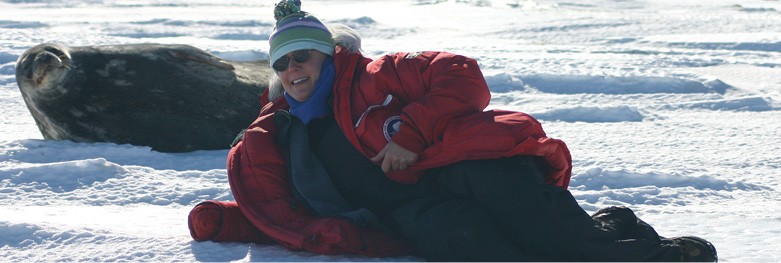
From One Good School to Another
Her father was gone, but Dorota was still Dorota. “I was always fascinated by stories of wanderers, explorers and early navigators,” Dorota said. “And that was one of the reasons I chose to study surveying.” Finishing high school with flying colors, she enrolled at the University of Warmia and Mazury in Olsztyn. In 1986, she received an MS in Surveying Engineering and Land Management with Highest National Distinction. The next year she married her high school boyfriend Robert, thus becoming Grejner-Brzezinska. In 1988, her daughter Bogna was born.
Another kind of romance also began during those years: “My satellite geodesy class curriculum included a section on GPS, and I got hooked from day one,” said Grejner-Brzezinska. “It was a love at first sight!” Unfortunately, GPS technology was not yet available in Poland. “We were still behind the Iron Curtain, so all I could do was gobble up every GPS-related article published, which only increased my desire to get my hands on the actual technology.”
Her Masters thesis was on GPS positioning accuracy, mainly based on simulations and covariance analysis. “I had to get to the bottom of the GPS case!” she said, “I wanted to understand what was fundamental, what was not yet established, and what opportunities for improvement remained. Following the advice of my professors, I applied for a scholarship to go to the USA to study GPS.”
The process leading to her selection as a Fulbright Scholar was complex and arduous. “I was thrilled!” she said, “The technical attaché who gave me the news said she thought I should go to MIT, to which I responded, ‘No, Ma’am, I am going to Ohio State!’ Everybody knew that The Ohio State University (OSU) was the world capital of geodetic science and satellite geodesy in particular. I wanted to learn directly from those who had co-created the civilian algorithms and were discovering the new science. I wanted to be in the middle of that action.”
Coming to America
Grejner-Brzezinska arrived in America in July 1990, with her husband and daughter, and in September started as a graduate student in the Department of Geodetic Science at OSU. She would eventually earn MS and a Ph.D. degrees, but her stint at OSU didn’t end there. “That one-year Fulbright stipend was my doorway to a lifelong love affair with this cool thing called GPS, and nearly 30 years later I am still at the same university and still learning!” she said. “Perhaps I am a slow learner?”
“I continued at OSU as a post-doctoral researcher, a research scientist, then assistant professor, associate professor, full professor, department chair, and now associate dean for research,” she said. “I have traveled the full academic path, while staying engaged in my lab and the field at large.”
Her research has mostly focused on algorithmic development, software implementation, and system integration. The prototyping done at the SPIN Lab has been based on the commercial-off-the-shelf (COTS) components. “Our mode of operation has been to design a new algorithm and dream up the type, accuracy, sampling rate, range, etc. for the desired sensory data, and implement a software that can demonstrate the desired outcome.”
Among the most groundbreaking achievements in high-accuracy GPS algorithms and methods she has been a part of:
• DESIGN AND DEVELOPMENT of novel algorithms and methods for high-accuracy GPS and low-Earth orbiters orbit estimation, and Earth rotation parameter estimation with GPS. Her contributions have pushed the state-of-the-art in the accuracy and speed of the GPS orbit estimation using novel algorithms based on carrier-phase triple differences that she developed and implemented during her PhD research.
• WORK TOWARDS the development and implementation of advanced positioning algorithms that assure cm-to-mm level GPS positioning accuracy to support a variety of applications.
• DESIGN AND IMPLEMENTATION of high-accuracy algorithms and multi-sensor system prototypes for navigation in GNSS-challenged environments. Grejner-Brzezinska’s OSU team leads in the development and implementation of integrated systems that include both GNSS and a high-accuracy inertial navigation system.
“Our work in the 1990s delivered a world-first airborne mapping system (AIMS) that was fully digital, with the first ever high-resolution, 16-megapixel digital camera, by Lockheed Martin Fairchild, and directly georeferenced with a GPS/ inertial measurement unit (IMU) positioning solution,” she said. “Our initial GPS/IMU solution was further augmented by other sensors, such as barometers and a compass, but the most important step in augmenting GPS/IMU delivered by my team was the design and implementation of a knowledge-based system to support the navigation filter with a human locomotion model that provided a navigation solution even when other sensors failed to navigate.”
Since then, the GNSS/IMU model has been adopted as a navigation standard. It is widely used in civilian and military vehicles, unmanned aerial vehicles (UAVs or drones), for personal navigation, construction machinery, precision farming, etc. Examples include the use of GNSS/IMU for autonomous navigation, augmented by radar, LiDAR, and digital cameras.
“Recently my team worked on image and LiDAR-based navigation. We implemented novel algorithms for crowd-sourcing-based indoor navigation and image-based autonomous navigation.”
• DEVELOPMENT OF A NOVEL, fast and accurate algorithm that uses ionospheric disturbance filtered from GNSS signals to detect and locate clandestine nuclear explosions and earthquakes.
“My research has spanned continents taking me to remote areas of Australia, Argentina, Brazil and Africa. In the Mojave Desert we simulated a Mars descent, and I participated in a San Andreas Fault mapping mission in 2005. I have travelled to McMurdo Station in Antarctica, where an OSU geology team set up GPS receivers to estimate post-glacial rebound due to melting ice.”
The latest accomplishment on her impressive list is being named to the National Space-Based Positioning, Navigation, and Timing Advisory Board and being inducted to the National Academy of Engineering.
“The one thing I regret is that my father, who loved maps like I do and who bought them for me when I was a child, never got to see me fulfill my dreams.”
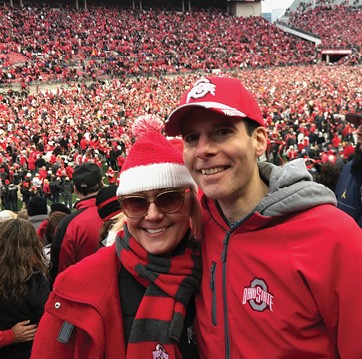
And Life as Well
“When I came to the United States nearly 30 years ago with my husband and our daughter, we had absolutely no plans to stay,” Grejner-Brzezinska said. “I was going to learn about GPS and then we would go back to Olsztyn after our American adventure.” Instead, she has remained in America. She still travels to Poland to see her mother and sister, but it’s when she returns to Ohio that she feels at home.
“When we arrived, we had no safety net, no family or close friends to help us with Bogna. I have fond memories of her coming with me to graduate classes at OSU when Robert was still at work and the day care closed at 5 pm. Later on, when she was in junior high and high school, I have to admit to missing a few of her swim meets, track and field competitions, and voice and flute recitals. While I tried to juggle my calendar as best I could, it did not always work out.
“But with effort and determination we made it. I watched my daughter grow from the cutest baby in the world, with an absolutely sunny disposition, to a bright and a bit shy little girl, to a confident young woman who is close to completing her medical residency in obstetrics/gynecology and plans to further specialize in gynecological oncology.” Bogna is getting married in 2020.
“Unfortunately, Robert and I drifted apart over the years, and got divorced when Bogna went to college,” said Grejner-Brzezinska. “But we are still here, all three of us, and we still spend holidays and Bogna’s birthdays and other important events in her life together. She will always have a mom and dad who love and support her, even though we are no longer together.
“Four and a half years ago, I met my fiancé, David Dean,” she said. “He is a geek like me, also an academic. We are getting married on August 28, although we haven’t decided on the year yet. We met on August 28 and David proposed on August 28. We’ll never lose track of the anniversaries.”
Among the things she shares with her beau is a passion for the very strange sport of American football, which, at The Ohio State University, is a thing to behold. “For the longest time I was perplexed by the whole football culture at OSU, but today I am a true Buckeye,” she said. “David and I attend the home games, joining a hundred thousand of our best friends at The Shoe to see them win over and over again. If they occasionally lose, they are still my team!”
The boys in scarlet and gray are surely glad to have Dorota A. Grejner-Brzezinska on their side. Disciplina in civitatem.
